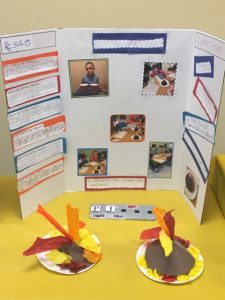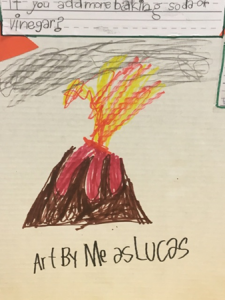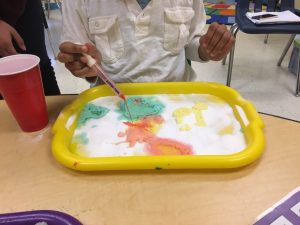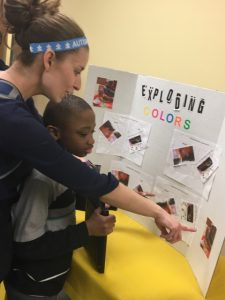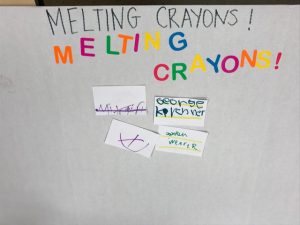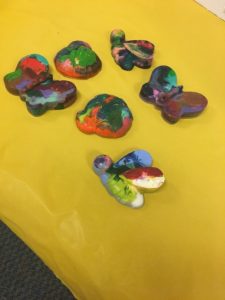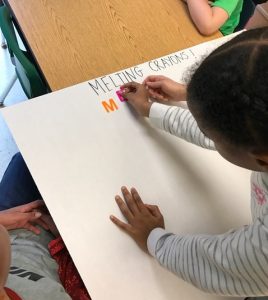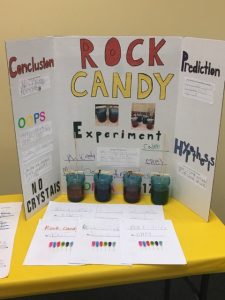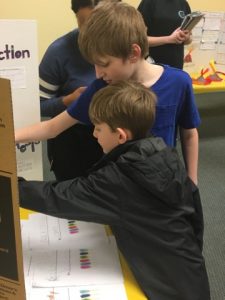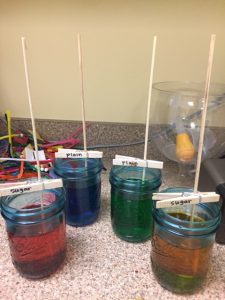
Published on: April 28, 2017
Throughout the month of March, the classes at The Shafer Center explored physical and chemical science. Students performed a variety of science experiments by following the scientific method (forming a guess or hypothesis, performing the experiment, noticing any “results” or changes, and if their guess or hypothesis was correct or not). Upon discovering their favorite experiment, each class chose one experiment to showcase at the Science Fair that was held at the end of March.
The Inspire classroom created a volcano for their science fair demonstration. Before their experiment, each student wrote out the scientific process that they would follow: they recorded the materials that would be needed, the testable question, and their hypothesis. Then the class observed the chemical reaction between baking soda and vinegar within their plaster volcano, which they had created in the days prior. After their experiment, each student wrote a sentence explaining the results that they noticed (any changes) and a conclusion about what happened when baking soda was added to vinegar. For example, “When we used more vinegar the eruption of the volcano was bigger!” and “In conclusion, the volcano was awesome!” The day before the science fair, the class prepared by attaching their writing to the poster board and sharing the responsibility of decorating it together.
To try the Inspire Volcano: http://www.sciencekids.co.nz/experiments/vinegarvolcano.html
The Imagine class explored chemical reactions by mixing baking soda and vinegar, as well but forming an entirely different result called “Exploding Colors!” Students added colored vinegar to baking soda and observed the fizzing bubbles that resulted. Students practiced physically and actively following the scientific method and summarized the activity. Students performed the experiment and decorated the board by following step-by-step instructions to form their final product. Throughout the experiment and demonstration for the Science Fair, students were also working on many skills relevant to their individual goals which included color identification, fine motor, and sequencing the steps of a task. One teacher shared her experience, “I loved doing the “Exploding Colors” experiment with the Imagine kiddos. The expressions on the kids’ faces were priceless when the fizzing occurred. They were really excited each time we brought out the materials for the experiment and their favorite part was squeezing the colored vinegar onto the baking soda.”
To try Imagine’s Exploding Colors: http://happilyevermom.com/rainbow-baking-soda-vinegar-experiment/
The Believe and Envision classes worked together in observing a physical change by making their own crayons, calling their project “Melting Crayons”! The students were able to learn how to work on a project not only in a group, but with schoolmates from another class. The Believe students quickly adapted to going to a separate, different location to work on a project with peers they are not familiar with working with. They very successfully communicated, with support, and created a cohesive project as a unit with the Envision class. Students practiced following the steps of the scientific method, with an emphasis on making and confirming predictions. With these classes working together, students had the opportunity to practice skills across a variety of areas, including academic and social. Students followed the scientific method by actively preparing the materials needed (crayons). The students peeled the crayons, sorted them by color, and then followed directions to sequence the steps of the experiment. They started with placing the broken, peeled crayons into the mold and deciding if when placed in the microwave they would remain the same physically or be different. After that, they observed what happened as they were placed into the microwave alongside peers with encouraged commenting, and then finally concluding if the crayons had remained the same in physical presentation or were different. They recorded their results on a recording sheet and when the experimentation was complete, students worked with their peers to put together the poster by placing a title, labeling parts of the board, taking turns cutting, pasting and gluing, and setting it up for the fair.
To make your own Believe/Envision crayons: http://www.skiptomylou.org/making-crayons-using-molds-craft-camp/
Dream experimented with a chemical and physical change by making rock candy! Students had a true experimental experience as their experiment did not work the first time. They noticed that crystals were not forming through their original scientific process and had to change one of the materials. Students followed science safety as a string (originally) was added to colored, heated sugar. The Dream class followed the scientific method by keeping a science journal tracking the progress of their rock candy. After a couple of days, students noticed that crystals were not forming as they were supposed to on the string and changed the material of the string to a wooden stick and tried the experiment again. Finally, crystals began to form on the stick, creating their homemade rock candy! Students practiced the scientific method and also acknowledging that science experiments do not always work and changes to the process need to be made. Students also practiced recording results or changes (or the lack of), over a period of time and concluding what materials worked best and what the chemical and physical changes were.
To make Dream homemade rock candy: https://www.stevespanglerscience.com/lab/experiments/homemade-rock-candy
Please follow the links attached to each class’ experiments to recreate them at home with your child! Students were invested in their experiments and ecstatic to share them on the day of the science fair with friends and family; we’re sure they would love to try other class’ experiments, or even show you their own class experiment by re-creating it at home!
By Ananda Singh
For more information on The Shafer Center contact 410-517-1113 or email [email protected].
